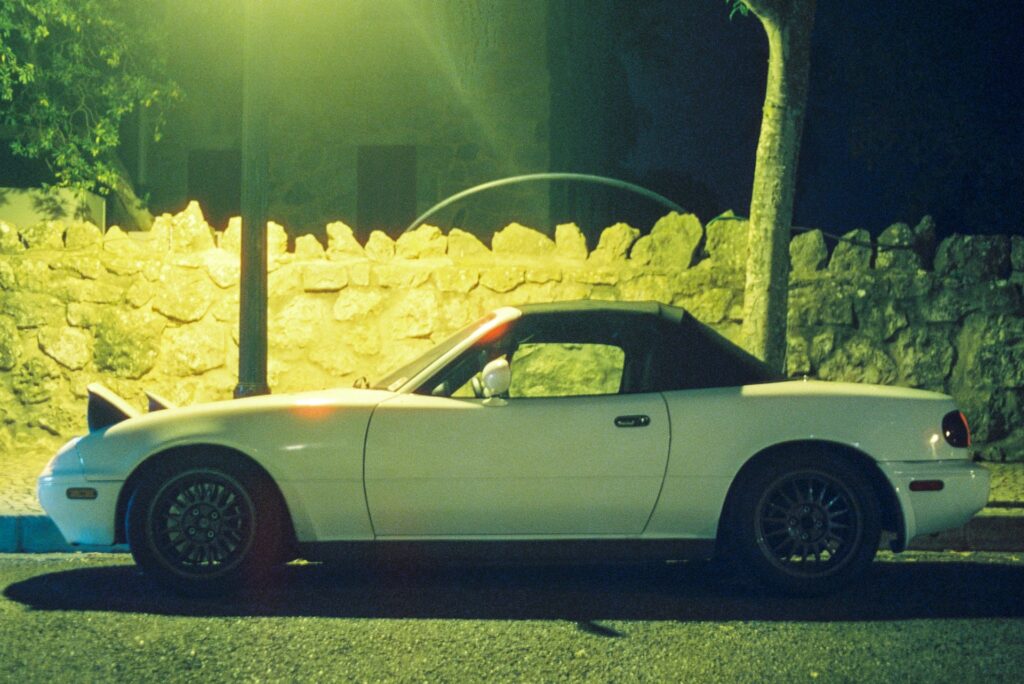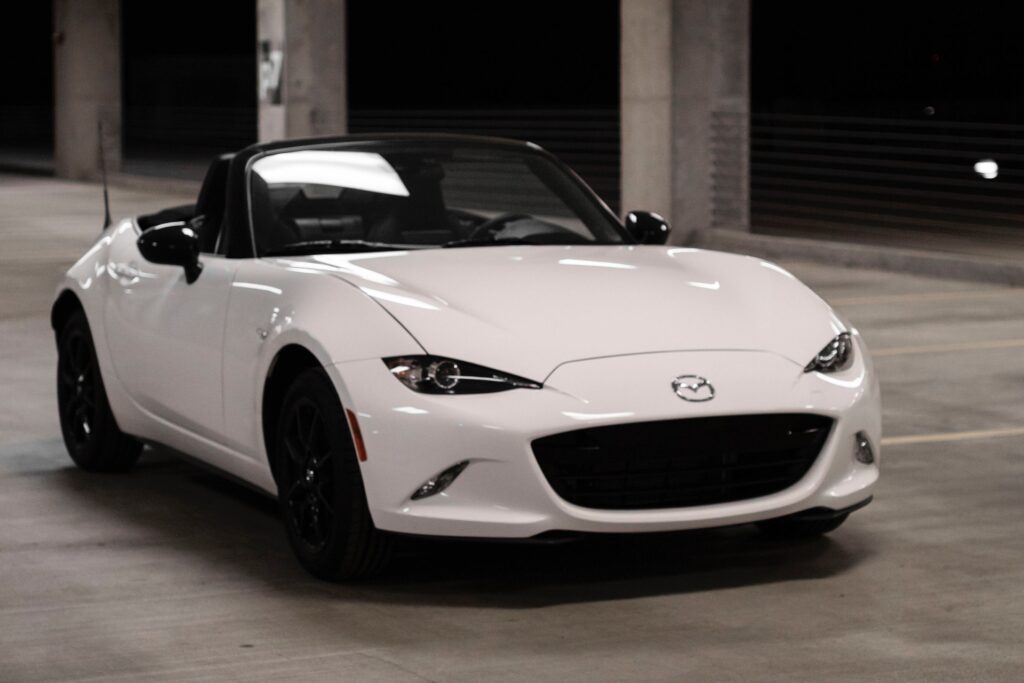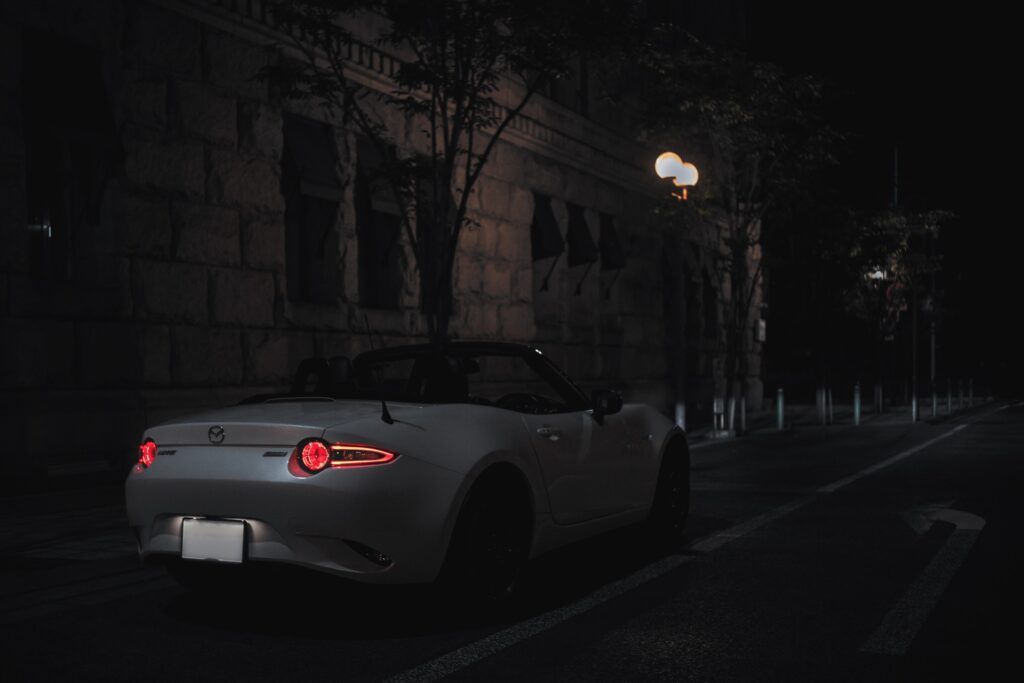
As an Amazon Associate, Modded gets commissions for purchases made through links in this post.
The Mazda Miata is a canvas for automotive artists to paint as they please. This tiny car packs a punch with its stock engine, but you can take it to the next level by swapping the engine. What are the best Mazda Miata engine swaps? Knowing which motors work for your vehicle is critical before getting the tools out. Here’s a guide to making your modded Mazda Miata the coolest one on the block.
What Are the Best Mazda Miata Engine Swaps of 2024?
Choosing an engine swap over forced induction lets you get creative with your customization. The motor you pick will significantly influence your performance, so carefully scrutinize each option. These nine Miata engine swaps heighten power, handling, efficiency and more.

Hellcat
When you think of motor swaps, a Miata with a Hellcat engine might not be the first to come to mind. Still, you should consider the Dodge SRT Hellcat’s engine if you’re looking for power. The Mazda MX-5 Miata maxed out at 181 whp, whereas the Hellcat gives you over 700 whp at 6000 RPM.
One thing you’ll need to consider is the weight distribution. The Hellcat weighs over 4,000 lbs and gives you one of the biggest engine options in a Miata, significantly affecting your vehicle’s handling.
The Hellcat’s V8 engine would disrupt your Miata’s balance, sending the weight to the front and making driving more challenging. Suddenly, driving around curves and corners becomes dangerous.
The Miata’s engine bay is designed to have a small motor, so fitting this V8 engine will require you to modify the subframe, exhaust system, engine mounts and more. The sheer size makes the motor more suitable for a Dodge Ram, but it can fit with the magic touch.
- Compression Ratio: 9.5:1
- Displacement: 6.2L (6,166 cc)
- Piston Stroke: 90.9mm
- Power: 717 whp
- Torque: 649 wtq
- Weight: 247-259kg
GM LFX V6
If you want a powerful engine but are hesitant about the Hellcat, consider the GM LFX V6. This motor provides a terrific spark of power but fits more naturally into your Miata. You’ll get up to 323 whp from this high-performing lightweight engine.
You’ll typically find the LFX V6 in Chevrolet Camaros, so imagine that comparison in your Miata engine swap. The exhaust note alone impressed us on this engine swap, so it’s worth the time if you want increased torque and a more muscle-car feel.
The LFX V6 is bigger, but your Miata’s engine bay should accompany the new engine without much adjustment. The motor is also longer, so the weight distribution won’t be a limiting factor.
- Compression Ratio: 11.5:1
- Displacement: 3.6L (3,564 cc)
- Piston Stroke: 85.6mm
- Power: 300-323 whp
- Torque: 264-278 wtq
- Weight: 157kg
If you want a more eco-friendly Miata swap, the GM Ecotec engine is a solid option. This motor might not be as fuel-efficient as hybrids on the market, but it has enhanced fuel efficiency.
Honda K20
The Honda K-Series engines provide the easiest Miata engine swap selections because they fit seamlessly. This exchange is preferable if you have less experience with engine swaps or don’t want to alter your Miata too much.
The K-20 motor’s performance depends on your selection because there are plenty of options. The K20A1 is the first in the series, featuring 156 whp at 6,500 rpm and 139 lb-ft of torque.
Regardless of your pick, the K20 is much lighter and maintains your Miata’s ideal weight distribution. Thus, your Miata will continue to excel in its handling and balance.
Choosing the K20 gives you variability because this engine’s aftermarket support is robust. You can further tune the motor to your liking and add even more whp if desired. Plus, the aftermarket makes it easier to repair if something goes awry.
- Compression Ratio: 9.7:1 – 11.7:1
- Displacement: 2.0L (1,996 cc)
- Piston Stroke: 85.9mm
- Power: 156-306 whp
- Torque: 139-295 wtq
- Weight: 183.7kg

Honda K24
Honda is a solid automaker for young people buying cars and anybody wanting a reliable vehicle. That said, the Japanese manufacturer also makes excellent engines for swaps.
The Honda K24 is among the most common Miata engine swaps, with Soichiro Honda’s K-Series engines fitting well inside your vehicle. They’ll work similarly in your Miata, but there are a few differences to consider.
The K24 has a higher displacement at 2.4L, allowing you more torque and power than the average engine. Picking a K24 engine adds over three kilograms to your engine bay, which may seem minuscule. Still, the difference could be significant for your Miata’s weight distribution.
Selecting between the two depends on your preferences. The K24 offers more low-end torque, whereas the K20 offers higher rpm. In terms of price, the K20 is generally more affordable due to its long life on the market.
- Compression Ratio: 9.6:1 – 11.6:1
- Displacement: 2.4L (2,354 cc)
- Piston Stroke: 99.0-99.1mm
- Power: 160-206 whp
- Torque: 162-182 wtq
- Weight: 187kg
Honda J-Series V6
Honda engines fit well inside Miata engine bays, so you should also consider the J-Series. These V6 engines are popular alongside the LFX swaps because of their high horsepower and increased performance.
The J-series has numerous options varying in horsepower and displacement, allowing flexibility in your swap. This wide selection makes it a contender to be the easiest Miata engine swap on the market.
J-Series engines are lightweight, starting as low as 113kg and maxing out around 163kg. Thus, the transition to these engines will be easy for your Miata. The low-end torque makes it easy to keep your Miata as a daily driver.
There are some challenges with the J-series engines. For example, the aftermarket community isn’t as large as the K-series and other engines. Plus, these V6 engines have unique wiring and electronic systems that may confuse the average Miata owner when transitioning.
- Compression Ratio: 10.0:1 – 11.2:1
- Displacement: 3.5L (3,471 cc) – 3.7L (3,664 cc)
- Piston Stroke: 89.0-90.0mm
- Power: 205-310 whp
- Torque: 217-275 wtq
- Weight: 113-163kg
LSx V8
If you kick it old school, the LSx V8 engine suits you. An LS-swapped Miata is more common for older models, so consider that when looking at your options. The LS engines have a large community worldwide, so finding swap kits and advice will be more manageable than other motors.
These engines are best if you want high horsepower with a lighter engine than the SRT Hellcat. The weight will slightly affect the Miata’s handling, so consider suspension changes with the LSx V8.
The Miata engine bay fits this V8 engine without much of a hitch. You may need to adjust the firewall or mounts or cut the frame rails to fit your NA or NB Miata, making the LS swap easier if you have the NC Miata.
Like the K-Series, the LS engines have a long history and numerous editions. The 5.3L engine is the most common LS motor and could be the one in your Miata.
- Compression Ratio: 9.6:1
- Displacement: 5.3L (5,327 cc)
- Piston Stroke: 91.95mm
- Power: 300-326 whp
- Torque: 330-348 wtq
- Weight: 195-226kg

Mazda 13B
Looking at the best engine swap options, you may hesitate to shoot for a rotary swap. However, you should consider it, starting with the Mazda 13B. It may seem painful, but it’s worth the time.
The 13B engine matches well with the third-generation NC Miata, which Mazda produced from 2006 to 2015. The 13B’s rotary design is beneficial because of its power delivery and wider broadband. Therefore, it’s way more fun to drive.
You may encounter some problems with the 13B motor because rotary engines are unique. These engines are typically less fuel efficient than your Miata’s piston engines. Plus, they often require more maintenance.
However, you’ll love the 13B when you hear the rotary engine. Mazda has made the 13B since 1978, so you have plenty of options for your swap.
- Compression Ratio: 8.5:1 – 9.7:1
- Displacement: 1.3L (1,308 cc)
- Piston Stroke: N/A
- Power: 135-280 whp
- Torque: 130-231 wtq
- Weight: 149-152kg
Nissan SR20DET
If you’re searching for a turbocharged engine, the Nissan SR20DET has you covered. This engine has electronic fuel injection and gives the Nissan compact sports their power.
Giving your Miata an SR20 engine allows flexibility on the horsepower, with the standard editions around 200 whp and the modded versions eclipsing 300 whp. The turbocharged engine also allows for better low-end and mid-range torque. Miatas aren’t muscle cars, but they’ll feel closer to that standard with this swap.
A significant benefit of the SR20DET is its weight. It’s not exactly a feather with its 400-pound weight — but it will maintain the superb handling on your Miata. Another factor to consider is the SR20 has a large aftermarket community, making it easy to adjust your Miata even more after your engine swap.
Compression Ratio: 8.5:1 (red top, silver top) 8.5:1 / 8.3:1 (black top)
Displacement: 2.0L (1998 cc)
Piston Stroke: 86mm
Power: 201-246 whp
Torque: 203 wtq
Weight: 181kg
Toyota 1GZ-FE V12
The Hellcat isn’t the only unconventional engine swap on the list. If you’re looking for power, the Toyota 1GZ-FE V12 engine packs a punch and will elevate your Miata to the next level.
This V12 engine — like the Hellcat — would increase the horsepower to over 300. Your acceleration and top speed will get much higher. However, the weight will also drastically affect your Miata.
The 1GZ-FE V12 weighs about 300kg and is the biggest engine you can put in a Miata. You’ll need to overhaul the mounts and other supporting engine components.
Nonetheless, the swap is worth it if you want a loud and proud motor. When you hear a Miata with a V12 inside, you’ll understand why we love this engine swap so much.
- Compression Ratio: 10.5:1
- Cylinder Bore: 81mm
- Displacement: 4.9L (4996 cc)
- Piston Stroke: 73.7mm
- Power: 280-312 whp
- Torque: 460-481 wtq
- Weight: 295kg
Toyota 2JZ-GE
Another Toyota engine worth considering is the 2JZ, one of the most popular motors from the 1990s and 2000s. Toyota manufactured the engine from 1991 to 1996 and divided it into two generations.
If you want your Mazda Miata modded with a Toyota engine, the 2JZ offers a couple of options. The GTE gives you more performance but is far from the cheapest Miata engine swap.
The 2JZ-GE is a more budget-friendly accommodation and packs a punch with its power. If you like Toyota power, you may also like the 1.5JZ.
Like Toyota’s V12 engine, you must consider the 2JZ-GE’s size and weight. A 230kg engine may need special accommodations to ensure it doesn’t harm your Miata.
- Compression Ratio: 10.0:1 (10.5:1 with VVT-i system)
- Cylinder Bore: 86m
- Displacement: 3.0L (2,997 cc)
- Piston Stroke: 86mm
- Power: 215-230 whp
- Torque: 279-304 wtq
- Weight: 230kg
Finding the Easiest Miata Engine Swap
Before purchasing an engine and grabbing the torque wrench, it’s essential to understand how engine swaps work. Here are eight factors you need to consider when undergoing this process.
Compatibility
The first measure is to ensure your Miata is compatible with the engine you’re inserting. For example, examine your engine mounts to align the motor inside your engine bay correctly.
Getting the correct mounts for your Miata engine swap is crucial to setting up the rest of the process. Look at the transmission as an example — the mounts align your engine with the transmission to transfer power. You’ll be in trouble from the start with incompatible engine mounts.
Weight
Next, consider the weight. Miatas are famously lightweight and fun to drive. You’ll need to watch the weight of your engine swap to ensure you get the same experience.
Specifically, you’ll need to watch the weight distribution. A dramatic weight change can negatively affect your balance and fundamentally change the car. Ensure the Miata engine swap has the same or an improved weight distribution to maintain your handling.
Tuning Goals
Tuning is one of the most fun things you can do with a car. That said, you must enter the task with a basis of what you want to do. Are you looking for the easiest or cheapest Miata engine swap? If you have a large budget, you could swing for the fences and get a big engine.
After you understand your budget, move to the performance aspects. Are you looking for better fuel mileage or engine performance? Consider the horsepower, torque, handling and the other aspects of a good motor in your Miata.
Electrical System
One of the pesky parts of engine swaps is dealing with the electrical system. This complex infrastructure requires you to investigate the engine’s amperage, sensors and gauges.
Check the wiring harnesses, control modules, electrical fan circuits, and other parts of the electrical system in your Miata engine and the swapped motor. Do you need to modify the wiring? If so, you may need some aftermarket help linking the two.

Cooling System
Cooling systems are easier to swap than electrical units but still require work and investigation. Newer engines get much hotter than the one in your Miata from the ’90s, so you’ll need enhanced cooling for the motor.
Check your Miata’s radiator and intercooler to see if it can support the replaced engine. If not, you’ll need additional cooling components and modifications to assist your radiator. The last thing you want is a blown engine on your first day with what you thought was the best Miata engine swap.
Fuel System
Another critical component to inspect is your fuel system. Inspect your Miata’s fuel pressure, fuel pump capacity, injector size and more to keep them as close as possible to the swapped motor. Your priority should be ensuring fuel delivery is as smooth as your original engine’s.
Then, consider fuel compatibility. Your Miata uses gasoline, but the swapped engine may require diesel or alternative fuel. In this case, you’ll need to change the fuel tank, lines and injector to install the new system.
Exhaust
Nowadays, you don’t want to compromise engine efficiency, so your swap must consider the exhaust system. Check the swapped engine to ensure it’s compatible with your Miata’s exhaust manifold. A good exhaust system means you’ll maintain your horsepower and torque, leading to increased performance on the road.
Plus, your exhaust system will significantly influence the noise emitted from your car. It’s essential to check the exhaust notes from your swapped engine to see if you need to make any alterations to the system.
Transmission
While a Miata with a Hellcat engine sounds fun, you must consider the transmission compatibility. Finding a great motor doesn’t matter if your engine and transmission don’t match.
How can you gauge their compatibility? Start by checking the gear ratios because it’s critical they match. If the engine is too powerful for the transmission, you’re in trouble because you’ll cause excessive strain and compromise performance.
Emissions Compliance
Noise pollution is a concern for your exhaust — so is greenhouse gas pollution. Twenty-nine states require emissions tests to register a vehicle, so emissions compliance should be one of your highest priorities in a state like California.
Your Miata’s exhaust system should have updated catalytic converters and oxygen sensors to control its emissions. One way to reduce your Miata’s emissions is to convert it into a battery-electric vehicle or use a highly efficient engine like the GM Ecotec.
Budget
Engine swaps are fun projects for gearheads, but you need to consider your budget for time and money. This process will take hours of manual labor and a few thousand dollars. However, look at the project as an investment — you’ll garner the benefits of a swapped engine, such as increased horsepower, torque and fuel efficiency.
If you’re not confident in your mechanical abilities, consider hiring a professional to exchange the engines. They’ll ensure your swap goes smoothly and may require less time and money than if you did the process yourself.
Are Miatas Easy to Work On?
If you decide to do the engine swap, you can help yourself by getting a Miata engine swap skit. This toolkit will set you up for success and ensure the process runs smoothly. Your homemade Miata swap kit should include these 10 items.
![collection of tools hanging on a wallCompression Tester
First, you should test your engine’s health, which you can accomplish through a compression tester. This device tells you the compression pressure in each engine cylinder. Low pressure could mean a few things, such as leaky valves, gasket issues or worn pistons.
Use your compression tester on the current and swapped engine to compare their health. You’ll have a baseline for the cylinder pressure, making it easier to diagnose engine problems down the road.
Hand Tools
Hand tools make the engine swap more manageable, so ensure your Miata engine swap kit includes the following:
Flathead and Phillips-head screwdrivers
Hammer
Impact and Allen wrenches
Socket set
Pliers
Pry bars
Engine Crane
Another way to make your engine swap easier is to have an engine crane, also known as a cherry picker. This device does the heavy lifting if the engine weighs too much for you to remove manually. You’ll also benefit from more precise positioning when aligning the engine mounts and increased safety for everyone involved.
Jack Stands
Removing your Miata’s engine makes the vehicle temporarily unstable, so you’ll need jack stands to maintain the balance during the engine swap.
Jack stands are preferable to hydraulic jacks because they’re reliable and provide adequate support for your car. The engine swap could take a few hours, so having jack stand support is essential.
Transmission Jack
While the engine needs support, don’t forget about your transmission jack. This tool is essential because you want to prevent this crucial part from falling. You also make it easier to work on if it needs assistance.
The transmission jack also heightens accuracy when you reinstall it in your vehicle. Prioritize good care for your transmission because you don’t want its light on your dashboard popping up on your first Miata drive.
Engine Mounts
Another critical point of support comes from your engine mounts. These devices keep your engine inside the bay and align the motor with the chassis.
Your new engine could be heavier or have a different weight distribution, so the engine mounts ensure the bay can support the load across the chassis. Also, revving the new engine could shift the motor, so having the mounts is essential.
Brackets
Brackets are tiny enough to fit in your hand but are integral to the engine swap process. Primarily, you’ll need them for your engine mounting. Your swapped engine may have different mounting points, so the brackets help your new motor adapt.
These are also critical for integrating every component of the swapped engine into your vehicle. For example, you may need brackets for the power steering pump, air conditioning compressor or alternator.
Fluid Transfer Pump
Before swapping engines, you’ll need to drain the old one of its fluids — including the oil, coolant, transmission fluid and more. Make the process easier with a fluid transfer pump in your Miata engine swaps because they ensure clean draining.
If you’re not careful, the fluid transfer could get messy. For example, the coolant system could begin bleeding after air pockets get trapped in it. Your transfer pump mitigates the bleeding by freeing the air in the cooling system.
Multimeter
Multimeters help before and after the engine swap to test the electrical components of your engine. This device lets you measure voltage and identify wiring issues or faulty sensors.
For example, multimeters are excellent for continuity testing. These devices can identify breaks in the wiring or open circuits. After using the multimeter, you’ll know if and where repairs are necessary for your engine’s wires.
Safety Gear
Don’t discount safety when working on your engine swap. You never know what accidents can arise, so the last thing you want is an injury in your garage.
Protect your body and garage by assembling a first-aid kit and wearing eye protection at all times. Fires shouldn’t be an issue because Miatas are easy to work on and don’t carry this risk. If you work with power tools, wear ear protection to safeguard your hearing.
Comparing Forced Induction and Engine Swaps
Miata engine swaps are popular upgrades if you want something different under the hood, but you can opt for forced induction instead. Which route should you take? Let’s look at the benefits of each.
Forced Induction
Forced induction is popular if you want to turbocharge your Miata. The pros of forced induction include the following:
Originality: Using forced induction, you can keep your current engine. If you’re a Miata purist, you’ll appreciate maintaining the identity of your engine.
Cost: You’re keeping the engine in place, so forced induction costs are typically lower than engine swaps. Plus, it’s more convenient because it involves much less hassle on the mechanical side.
Aftermarket: The Mazda Miata community is extensive, so you’ll have an easy time finding turbocharger kits for your Miata. These tools make your installation much more manageable.
Engine Swaps
The engine swap option may be more complicated, but it has these benefits compared to forced induction.
Power: Turbochargers and superchargers can increase your power, but engine swaps heighten your power potential and performance.
Customization: Forced induction is relatively straightforward, but engine swaps let you be creative with your Miata. As you’ll see later in the guide, there are numerous engines you can take to achieve the performance you like.
Reliability: If you’re looking for reliability, engine swaps are the better choice. Engine swaps can increase the dependability of your Miata if you choose a durable and robust engine. Forced induction can become a liability by overstressing engine components if you don’t closely manage them.
Getting Creative With the Best Mazda Miata Engine Swaps
The Mazda Miata is a blank canvas for gearheads worldwide. You can create a Miata with a Hellcat engine or a Camaro motor to emulate other famous cars.
How can you make the vehicle your own? Set up a budget and determine which engine is the most compatible with your Miata and your wallet.
Also, remember forced induction is also an option if you want a turbo boost. This tuning ensures your Miata is the fastest car in your friend group.
Looking to continue improving your engine? Check out our list of the best modifications for better engine performance.
Originally posted [Jul 28, 2023] - Updated [Jul 24, 2024]](https://modded.com/wp-content/uploads/sites/9/2024/08/tool-collection-1024x683.jpg)
Compression Tester
First, you should test your engine’s health, which you can accomplish through a compression tester. This device tells you the compression pressure in each engine cylinder. Low pressure could mean a few things, such as leaky valves, gasket issues or worn pistons.
Use your compression tester on the current and swapped engine to compare their health. You’ll have a baseline for the cylinder pressure, making it easier to diagnose engine problems down the road.
Hand Tools
Hand tools make the engine swap more manageable, so ensure your Miata engine swap kit includes the following:
- Flathead and Phillips-head screwdrivers
- Hammer
- Impact and Allen wrenches
- Socket set
- Pliers
- Pry bars
Engine Crane
Another way to make your engine swap easier is to have an engine crane, also known as a cherry picker. This device does the heavy lifting if the engine weighs too much for you to remove manually. You’ll also benefit from more precise positioning when aligning the engine mounts and increased safety for everyone involved.
Jack Stands
Removing your Miata’s engine makes the vehicle temporarily unstable, so you’ll need jack stands to maintain the balance during the engine swap.
Jack stands are preferable to hydraulic jacks because they’re reliable and provide adequate support for your car. The engine swap could take a few hours, so having jack stand support is essential.

Transmission Jack
While the engine needs support, don’t forget about your transmission jack. This tool is essential because you want to prevent this crucial part from falling. You also make it easier to work on if it needs assistance.
The transmission jack also heightens accuracy when you reinstall it in your vehicle. Prioritize good care for your transmission because you don’t want its light on your dashboard popping up on your first Miata drive.
Engine Mounts
Another critical point of support comes from your engine mounts. These devices keep your engine inside the bay and align the motor with the chassis.
Your new engine could be heavier or have a different weight distribution, so the engine mounts ensure the bay can support the load across the chassis. Also, revving the new engine could shift the motor, so having the mounts is essential.
Brackets
Brackets are tiny enough to fit in your hand but are integral to the engine swap process. Primarily, you’ll need them for your engine mounting. Your swapped engine may have different mounting points, so the brackets help your new motor adapt.
These are also critical for integrating every component of the swapped engine into your vehicle. For example, you may need brackets for the power steering pump, air conditioning compressor or alternator.
Fluid Transfer Pump
Before swapping engines, you’ll need to drain the old one of its fluids — including the oil, coolant, transmission fluid and more. Make the process easier with a fluid transfer pump in your Miata engine swaps because they ensure clean draining.
If you’re not careful, the fluid transfer could get messy. For example, the coolant system could begin bleeding after air pockets get trapped in it. Your transfer pump mitigates the bleeding by freeing the air in the cooling system.
Multimeter
Multimeters help before and after the engine swap to test the electrical components of your engine. This device lets you measure voltage and identify wiring issues or faulty sensors.
For example, multimeters are excellent for continuity testing. These devices can identify breaks in the wiring or open circuits. After using the multimeter, you’ll know if and where repairs are necessary for your engine’s wires.
Safety Gear
Don’t discount safety when working on your engine swap. You never know what accidents can arise, so the last thing you want is an injury in your garage.
Protect your body and garage by assembling a first-aid kit and wearing eye protection at all times. Fires shouldn’t be an issue because Miatas are easy to work on and don’t carry this risk. If you work with power tools, wear ear protection to safeguard your hearing.
Comparing Forced Induction and Engine Swaps
Miata engine swaps are popular upgrades if you want something different under the hood, but you can opt for forced induction instead. Which route should you take? Let’s look at the benefits of each.
Forced Induction
Forced induction is popular if you want to turbocharge your Miata. The pros of forced induction include the following:
- Originality: Using forced induction, you can keep your current engine. If you’re a Miata purist, you’ll appreciate maintaining the identity of your engine.
- Cost: You’re keeping the engine in place, so forced induction costs are typically lower than engine swaps. Plus, it’s more convenient because it involves much less hassle on the mechanical side.
- Aftermarket: The Mazda Miata community is extensive, so you’ll have an easy time finding turbocharger kits for your Miata. These tools make your installation much more manageable.
Engine Swaps
The engine swap option may be more complicated, but it has these benefits compared to forced induction.
- Power: Turbochargers and superchargers can increase your power, but engine swaps heighten your power potential and performance.
- Customization: Forced induction is relatively straightforward, but engine swaps let you be creative with your Miata. As you’ll see later in the guide, there are numerous engines you can take to achieve the performance you like.
- Reliability: If you’re looking for reliability, engine swaps are the better choice. Engine swaps can increase the dependability of your Miata if you choose a durable and robust engine. Forced induction can become a liability by overstressing engine components if you don’t closely manage them.
Getting Creative With the Best Mazda Miata Engine Swaps
The Mazda Miata is a blank canvas for gearheads worldwide. You can create a Miata with a Hellcat engine or a Camaro motor to emulate other famous cars.
How can you make the vehicle your own? Set up a budget and determine which engine is the most compatible with your Miata and your wallet.
Also, remember that forced induction is also an option if you want a turbo boost. This tuning ensures your Miata is the fastest car in your friend group.
Looking to continue improving your engine? Check out our list of the best modifications for better engine performance.
Originally posted Jul 28, 2023 – Updated Aug 12, 2024
Stay up to date with the latest by subscribing to Modded Minute.
Author
Jack Shaw is a senior writer at Modded. Jack is an avid enthusiast for keeping up with personal health and enjoying nature. He has over five years of experience writing in the men's lifestyle niche, and has written extensively on topics of fitness, exploring the outdoors and men's interests. His writings have been featured in SportsEd TV, Love Inc., and Offroad Xtreme among many more publications.





